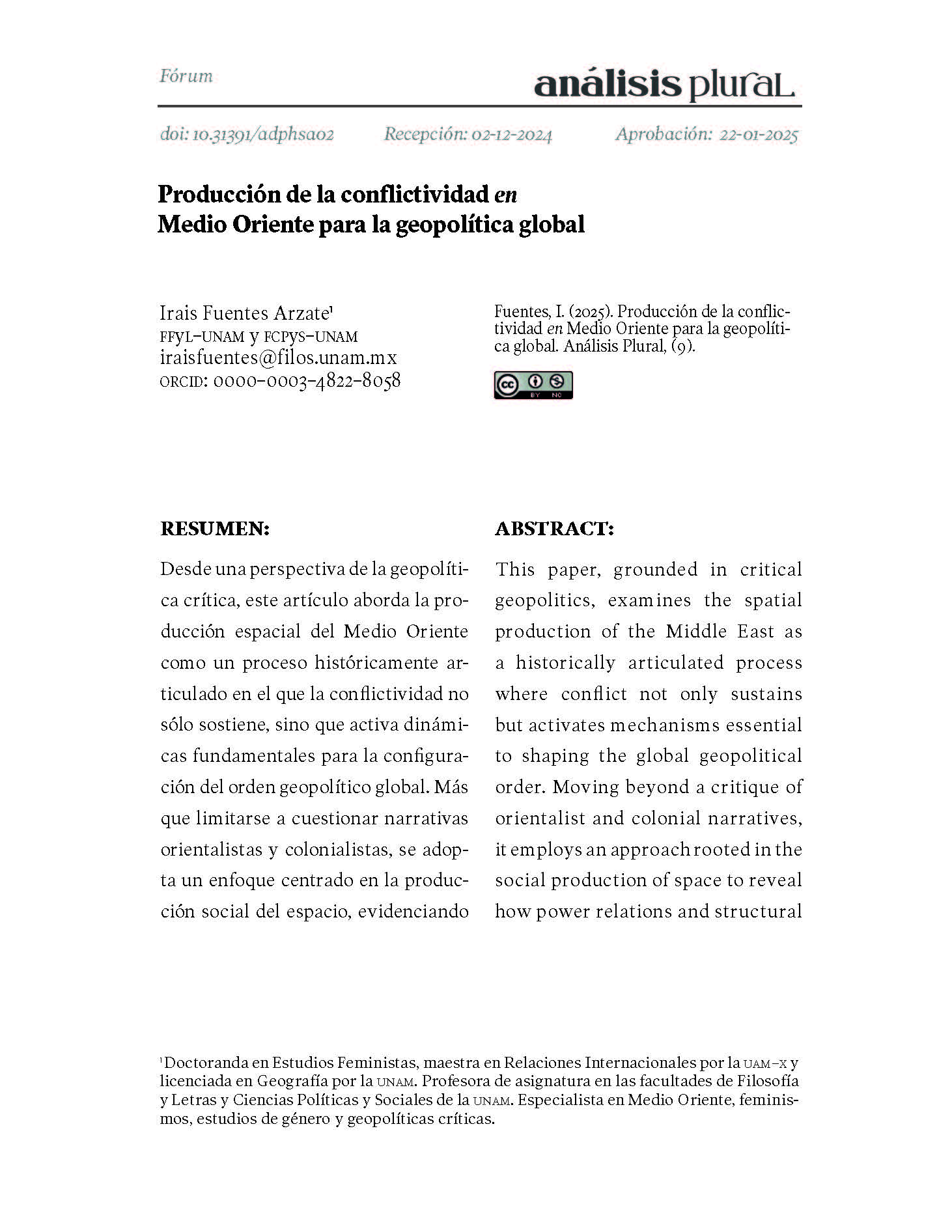Producción de la conflictividad en Medio Oriente para la geopolítica global
DOI:
https://doi.org/10.31391/adphsa02Palabras clave:
Medio Oriente, Conflictividad, Geopolítica crítica, Espacialidad, EstrategiaResumen
Desde una perspectiva de la geopolítica crítica, este artículo aborda la producción espacial del Medio Oriente como un proceso históricamente articulado en el que la conflictividad no sólo sostiene, sino que activa dinámicas fundamentales para la configuración del orden geopolítico global. Más que limitarse a cuestionar narrativas orientalistas y colonialistas, se adopta un enfoque centrado en la producción social del espacio, evidenciando cómo las relaciones de poder y violencia estructural son construcciones que emergen de procesos históricos y económicos orientados a consolidar hegemonías globales. En lugar de entender al Medio Oriente como un territorio intrínsecamente conflictivo, se analiza su producción dialéctica como espacio donde la conflictividad estructural es instrumentalizada para la reproducción del capital y la estabilidad del sistema internacional.
Descargas
Referencias
Agnew, J. (2003). Geopolitics: Re–visioning World Politics. (2ª ed.). Routledge.
Álvarez–Ossorio, I. (1999). El proceso de paz de Oriente Medio: historia de un desencuentro. Agencia Española de Cooperación Internacional.
Ansari, A. (2007). Modern Iran: The Pahlavis and After. Pearson Longman.
Bayat, A. (2017). Revolution without Revolutionaries: Making Sense of the Arab Spring. Stanford University Press.
Bellin, E. (2004). The robustness of authoritarianism in the Middle East: Exceptionalism in comparative perspective. Comparative Politics, 36(2), 139–157.
Blanco, J. M. (2011). Seguridad e inteligencia 10 años después del 11–S. Instituto Español de Estudios Estratégicos.
Bresheeth–Zabner, H. (2020). An Army Like No Other: How the Israel Defense Forces Made a Nation. Verso Books.
Cleveland, W. L., & Bunton, M. (2016). A History of the Modern Middle East (6ª ed.). Westview Press.
Conde, G. (2013). Siria en el torbellino: Insurrección, guerras y geopolítica. El Colegio de México.
Conde, G. (2016). La historia, clave para entender la actualidad del mundo árabe. En G. Conde et al., Mundo Árabe. Levantamientos populares, contextos, crisis y reconfiguraciones (pp. 257–404). El Colegio de México.
Conde, G. (2018). El Medio Oriente: entre rebeliones populares y geopolítica. Oasis, 28, 13–37.
Corte Internacional de Justicia (CIJ). (2024, 26 de enero). Application of the Convention on the Prevention and Punishment of the Crime of Genocide in the Gaza Strip (South Africa v. Israel) – The Court indicates additional provisional measures. https://www.icj-cij.org/sites/default/files/case-related/192/192-20240328-pre-01-00-en.pdf
Esposito, J. L. (1997). Political Islam: Revolution, Radicalism, or Reform? Lynne Rienner Publishers.
Esposito, J. L., & Shahin, E. E. D. (Eds.). (2013). The Oxford Handbook of Islam and Politics. Oxford University Press.
Fuentes–Arzate, I. (2024, 3 de octubre). Producción de la “conflictividad” en Medio Oriente contemporáneo para la geopolítica global [Ponencia]. Panel 8: Medio Oriente: conflictos, geopolítica y relaciones internacionales – IX Conferencia de Estudios Estratégicos “El Sur en la reconfiguración geopolítica: los rumbos de la transición”. La Habana, Cuba. https://www.cipi.cu/wp-content/uploads/2024/10/Propuesta-CIPI-.pdf
Gelvin, J. L. (2011). The Modern Middle East: A History (3ª ed.). Oxford University Press.
Halliday, F. (2005). The Middle East in International Relations: Power, Politics and Ideology. Cambridge University Press.
Herrera, D. (2017). Geopolítica. En Conceptos y fenómenos fundamentales de nuestro tiempo. Instituto de Investigaciones Sociales, UNAM.
Huntington, S. P. (1996). The Clash of Civilizations and the Remaking of World Order. Simon & Schuster.
Laurens, H. (2013). Europe and the Muslim world in the contemporary period. En J. Tolan et al., Europe and the Islamic World: A History (pp. 257–404). Princeton University Press.
Lockman, Z. (2010). Contending Visions of the Middle East: The History and Politics of Orientalism. Cambridge University Press.
Makdisi, S. (2002). The Culture of Sectarianism: Community, History, and Violence in Nineteenth–Century Ottoman Lebanon. University of California Press.
Özalp, O. N. (2011). Where is the Middle East? The definition and classification problem of the Middle East as a regional subsystem in international relations. Turkish Journal of Politics, 2(2), 6–21.
Pappé, I. (2006). La limpieza étnica de Palestina. Editorial Crítica.
Said, E. W. (2008). Orientalismo. Debolsillo.
Stockholm International Peace Research Institute (SIPRI). (2020). Las 25 principales empresas de armas y servicios militares de 2019. Recuperado de https://www.sipri.org/sites/default/files/2020-12/2020_sipri_top_25_press_release_esp.pdf
Sørli, M. E., Gleditsch, N. P., & Strand, H. (2005). Why is there so much conflict in the Middle East? The Journal of Conflict Resolution, 49(1), 141–165. https://doi.org/10.1177/0022002704270824
Tolan, J., Laurens, H., & Veinstein, G. (2013). Europe and the Islamic World: A History. Princeton University Press.
Vitalis, R. (2006). America’s Kingdom: Mythmaking on the Saudi Oil Frontier. Stanford University Press.
Voll, J. O. (2013). Political Islam and the state. En J. L. Esposito & E. E. D. Shahin (Eds.), The Oxford Handbook of Islam and Politics. Oxford University Press.
Wallerstein, I. (2005). Análisis de sistemas–mundo: una introducción. Siglo XXI.

Publicado
Número
Sección
Licencia
Derechos de autor 2025 Análisis Plural

Esta obra está bajo una licencia internacional Creative Commons Atribución-NoComercial-CompartirIgual 4.0.


